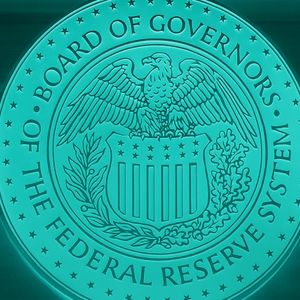Trump Warning: Fed Interest Rates Threaten US Economy
4 min read
Former U.S. President Donald Trump has once again weighed in on monetary policy, stating his belief that Federal Reserve Chair Jerome Powell is keeping Fed interest rates excessively high. This commentary, shared via economic news account Walter Bloomberg on X, reignites a familiar debate about the appropriate level of borrowing costs and their effect on the broader US economy . For participants in the crypto market, such high-level political commentary on economic policy is always noteworthy, as interest rate decisions can significantly influence risk asset valuations. Trump Criticizes Fed Chair Jerome Powell: A Recurring Theme Donald Trump’s recent criticism of Jerome Powell isn’t new. Throughout his presidency, Trump frequently expressed dissatisfaction with the Fed’s monetary policy, often advocating for lower interest rates to stimulate economic growth. His latest comments suggest this perspective remains unchanged. The core of his argument typically centers on the idea that lower rates make borrowing cheaper, encouraging investment, business expansion, and consumer spending, thereby boosting the economy. Key Points from Trump’s Stance: Belief that current rates are a drag on economic potential. Implicit call for the Federal Reserve to consider rate cuts. Continuation of a pattern of political pressure on the independent central bank. Understanding Fed Interest Rates and Their Role in the US Economy The Federal Reserve sets the target range for the federal funds rate, which is the interest rate banks charge each other for overnight borrowing. This rate serves as a benchmark that influences interest rates throughout the economy, including those for loans, mortgages, and savings accounts. The Fed uses this tool primarily to manage inflation and employment levels – its dual mandate from Congress. When inflation is high, the Fed typically raises rates to make borrowing more expensive, which cools down spending and investment, thus reducing price pressures. When the economy slows or faces recession risks, the Fed may lower rates to stimulate activity. The current high rates were implemented aggressively starting in 2022 to combat the highest inflation seen in decades. Jerome Powell and the Fed’s Balancing Act Under the leadership of Jerome Powell, the Federal Reserve has navigated a challenging economic environment. Their strategy has been to raise rates significantly to bring inflation down towards their 2% target, while trying to achieve a ‘soft landing’ – reducing inflation without causing a severe recession. Powell has consistently emphasized that the Fed’s decisions are data-dependent, focusing on inflation trends, employment figures, and other economic indicators rather than political considerations. The Fed’s Perspective (under Powell): Priority is to restore price stability by bringing inflation down. Current rates are seen as restrictive enough to achieve this goal over time. Decisions are based on economic data, not political pressure. Cautious approach to potential rate cuts, wanting to ensure inflation is sustainably low. The tension between political desires for lower rates and the central bank’s mandate to control inflation is a perennial feature of economic policy. Potential Crypto Market Impact of Interest Rate Debates The crypto market impact is often closely watched in relation to macroeconomic factors like interest rates. Cryptocurrencies, particularly Bitcoin and Ethereum, are often viewed as risk-on assets. This means they can perform well when liquidity is high and borrowing costs are low, making investors more willing to take on risk. Conversely, higher interest rates increase the appeal of ‘safer’ assets like bonds and can lead investors to reduce exposure to volatile assets like crypto. Trump’s call for lower rates, while not a direct policy action, contributes to the narrative around potential future monetary policy shifts. If the market perceives an increased likelihood of rate cuts (either due to political pressure or changing economic data), it could be seen as a positive signal for risk assets, including cryptocurrencies. However, the Fed maintains its independence, and political commentary doesn’t automatically translate into policy change. How Interest Rates Influence Crypto: Higher Rates: Increase the cost of capital, reduce liquidity, make traditional investments (like bonds) more attractive, potentially leading to decreased investment in crypto. Lower Rates: Decrease the cost of capital, increase liquidity, make traditional investments less appealing (lower yields), potentially increasing investment appetite for crypto and other risk assets. Actionable Insights for Investors For investors, particularly those in the crypto space, it’s crucial to distinguish between political commentary and actual monetary policy decisions. While Trump’s views are influential, the Federal Reserve operates independently. Keep an eye on official Fed communications, economic data releases (inflation, jobs reports, GDP), and statements from Jerome Powell and other Fed governors. These are the primary drivers of monetary policy. Understand that while interest rates are a significant factor, the crypto market is also influenced by technological developments, regulatory news, institutional adoption, and overall market sentiment. Conclusion: Navigating Political Winds and Economic Realities Donald Trump’s latest criticism of Jerome Powell and the current level of Fed interest rates highlights the ongoing tension between political goals and the central bank’s economic mandate. While Trump advocates for lower rates to potentially boost the US economy , Jerome Powell and the Federal Reserve remain focused on their fight against inflation, using data to guide their decisions on interest rate policy. For the crypto market, this debate is more than just political noise; it’s a reminder of how macroeconomics can influence asset prices. Staying informed about both political narratives and the Fed’s actual policy path is key to navigating these complex market dynamics. To learn more about the latest crypto market trends, explore our article on key developments shaping the crypto market price action.

Source: Bitcoin World



